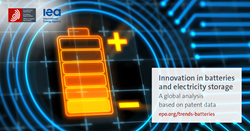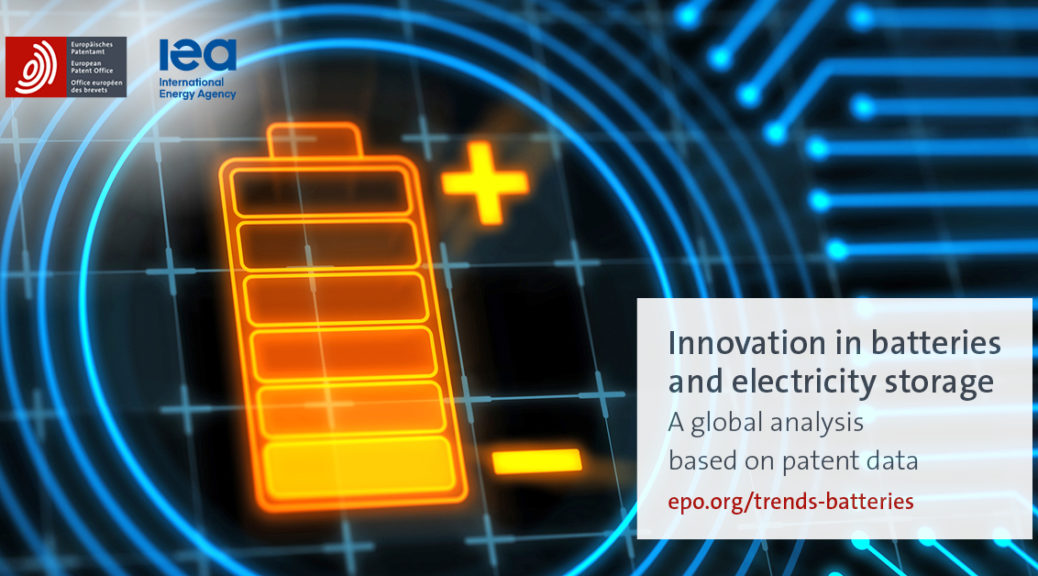
The rapid and sustained rise in electricity storage innovation shows that inventors and businesses are tackling the challenge of the energy transition. The patent data reveals that while Asia has a strong lead in this strategic industry, the U.S. and Europe can count on a rich innovation ecosystem,
MUNICH (PRWEB)
September 22, 2020
According to a joint study published today by the European Patent Office (EPO) and the International Energy Agency (IEA), improving the capacity of electricity storage solutions is playing a key role in the transition to clean energy technologies. Between 2005 and 2018, patenting activity in batteries and other electricity storage technologies grew at an average annual rate of 14% worldwide, four times faster than the average for all technology fields (3.5%). U.S. firms are lagging, with the U.S. in fifth place behind Japan, South Korea, Europe and China in terms of the number of international patents in battery technology.
The report shows that in the early 2000s, the U.S. was still the second most active patent-filing country, with only Japanese firms filing more patents in this field. But in 2010-11 South Korea and Europe overtook the U.S., as has China more recently.
Looking at the longer term from 2000-18 shows a different ranking: the U.S. holds a share of 14.5% of all patent applications in batteries (No. 4) compared to 6.9% for China (No. 5). Japan has been dominating the technology with a 40.9% of all patents in batteries in that period.
Overall, more than 7,000 international patent families related to electricity storage were published in 2018, up from 1,000 in the year 2000. Between 2000 and 2018, nearly 90% of the inventions aiming to improve electricity storage focus on advancements in batteries, in particular lithium-ion (Li-ion) cells used in consumer electronic devices and electric cars, far outweighing electrical (9%), thermal (5%) and mechanical (3%) electricity storage solutions. In 2018, innovation in Li-ion cells accounted for 45% of patenting activity related to battery cells, compared with just 7% for cells based on other chemistries (e.g. lead acid and nickel).
In Li-ion batteries, the U.S. emerged as the third strongest force: From 2014 to 2018, the country was home to the inventors of 12% of all Li-ion patenting activities globally.
U.S. STRONG IN EMERGING STORAGE TECHNOLOGIES
While the U.S. has lost some ground in patenting battery technologies that are currently the most manufactured, they are stronger in potential next-generation batteries. In the emerging NCA (lithium nickel cobalt aluminium oxide) chemistry for Li-ion batteries, the U.S. is the clear leader with 36% of related international patent families. The current NMC (lithium nickel manganese cobalt oxide) chemistry is expected to be replaced in due course with NCA as a promising alternative. NCA batteries are already being used by Panasonic and Tesla in electric vehicles.
In solid-state Li-ion battery patents – which could be an alternative to today’s Li-ion batteries using liquid or polymer gel electrolytes in the next decade – U.S. companies hold a 18% share of all related patents, ranking No. 2 behind Japan. And in Redox flow batteries, the United States is the dominant innovation center, accounting for almost one-third of all international patent applications in that field.
“Electricity storage technology is critical when it comes to meeting the demand for electric mobility and achieving the shift towards renewable energy that is needed if we are to mitigate climate change,” said EPO President António Campinos. “The rapid and sustained rise in electricity storage innovation shows that inventors and businesses are tackling the challenge of the energy transition. The patent data reveals that while Asia has a strong lead in this strategic industry, the U.S. and Europe can count on a rich innovation ecosystem, including a large number of SMEs and research institutions, to help them stay in the race for the next generation of batteries.”
“IEA projections make it clear that energy storage will need to grow exponentially in the coming decades to enable the world to meet international climate and sustainable energy goals. Accelerated innovation will be essential for achieving that growth,” said IEA Executive Director Fatih Birol. “By combining the complementary strengths of the IEA and the EPO, this report sheds new light on today’s innovation trends to help governments and businesses make smart decisions for our energy future.”
While innovation in battery technology is still largely concentrated in a limited group of very large companies, in the U.S. smaller companies, universities and public research organisations play a much more significant role than in the other countries leading in battery technology: For the U.S., SMEs account for 34.4% and universities/research organisations for 13.8% of all related patents filed.
Technical progress and mass production in an increasingly mature industry have led to a significant drop in battery prices in recent years – by nearly 90% since 2010 in the case of Li-ion batteries for electric vehicles, and by around two-thirds over the same period for stationary applications, including electricity grid management. In a scenario in which the technological potential for second use of batteries is fully utilized, cost reductions by 2040 would lead to batteries being 70% less expensive than today.
FURTHER INFORMATION:
Read the full study
NOTES TO THE EDITORS:
International patent families: The patent analysis in this report is based on the concept of international patent families (IPFs). Each IPF represents a unique invention and includes patent applications filed and published in at least two countries or filed with and published by a regional patent office, as well as published international patent applications. IPFs represent inventions deemed important enough by the inventor to seek protection internationally, and only a relatively small percentage of applications actually meet this threshold. This concept can therefore be used as a sound basis for comparing international innovation activities, as it reduces the biases that may arise when comparing patent applications across different national patent offices.
ABOUT THE EPO
With nearly 7,000 staff, the European Patent Office (EPO) is one of the largest public service institutions in Europe. Headquartered in Munich with offices in Berlin, Brussels, The Hague and Vienna, the EPO was founded with the aim of strengthening co-operation on patents in Europe. Through the EPO’s centralised patent granting procedure, inventors are able to obtain high-quality patent protection in up to 44 countries, covering a market of some 700 million people. The EPO is also the world’s leading authority in patent information and patent searching.
ABOUT THE INTERNATIONAL ENERGY AGENCY
The International Energy Agency (IEA) is at the heart of global dialogue on energy, providing authoritative analysis, data, policy recommendations, and real-world solutions to help countries bring about secure and sustainable energy for all. Taking an all-fuels, all-technologies approach, the IEA advocates policies that enhance the reliability, affordability and sustainability of energy. The IEA is supporting clean energy transitions all over the world in order to help achieve global sustainability goals.
#BatteryDay #BatteryDay2020 #BatteryInnovation
Share article on social media or email:

